Scholar
This page includes extensive quotes cited as Jon Bream. It comes from an article about Coffeehouses in the Minneapolis Star dated December 16, 1975.
The Ten O’ Clock Scholar, perhaps true to its beatnik reputation, is difficult to pin down.
Jim Helling
Most agree that the Scholar was started by Jim C. Helling. But Helling’s obituary says that he opened the Scholar in Dinkytown, by the University of Minnesota – Minneapolis Campus in 1953, opened another on the St. Paul campus of the University of Minnesota, and closed them both a couple of years later. Helling went on to develop Gallivan’s, the Fox and Hounds, and Eddie Webster’s in the Twin Cities. He would operate each restaurant for a year and turn them over to someone else. (Minneapolis Tribune, June 29, 1994)
Another article says that the Scholar had its start on the St. Paul campus in the mid fifties and moved to Dinkytown in 1958. (Allan Holbert, Minneapolis Tribune, July 3, 1966)
Obviously this doesn’t compute.
418 – 14th AVE. SE
Building History
This building was built before 1888. In 1927 – 1935 there was a restaurant at the location, which was for sale during the 1930s. There were also apartments in the building. In 1945 it was the Campus Exchange, where you could trade your used clothing in. Later that year it became Campus Wardrobe.
1958
The first mention of the “Ten O’Clock Scholar” in the Minneapolis papers is on December 8, 1958, announcing an art show by Roberg Berg.
Bream wrote that it opened in 1958 in a former restaurant at this address:
The small storefront, which served sandwiches and espresso coffee, attracted local foot traffic at first. It became a hangout for aspiring guitar players and chess-playing university types who held “self consciously intellectual discussions,” said Scholar regular Dave Matheny, who lived next door to the coffeehouse and painted its window sign.
In his survey of coffee shops called “Java Jive” in the Tribune’s Sunday Magazine (February 18, 1990), Jim Fuller described:
It was dingy to the point of looking 50 years old the day it opened. It served bad coffee, decent teas and some soft drinks and snacks – it was two or three years old and into a second or third set of owners before it acquired an espresso machine. Performers, mostly folk singers, sat in front of the store windows, just to the right of the door as you came in. Mostly they worked for whatever the student patrons would drop into the hat or cup or whatever was used for tips.
It soon became one of the area’s best known folk music venues. The 4-inch raised stage stood in front of a large plate-glass window. The long room held maybe 50 customers on unmatched tables and bar stools, and there was a long bench along the wall. In the back was a coffee bar that also included 30 different kinds of tea. During the day it was a coffee shop where customers could hang out and play chess. At night there was poetry and music – not just folksingers, but flamenco and blues musicians as well.
John Koerner
The photos below were taken by University student Bill Savran in 1958. These photos are used by permission.
Savran wrote of the Scholar and of Koerner:
The folks that gathered at The Scholar were philosophers, alcoholics, grad students, writers, poets, wannabe writers and poets, hangers-on, musicians of all kinds: strummers, singers, tambourine shakers, bongo thumpers, mouth harpists and so on. Spider John Koerner was a standout and of unique natural talent. I met him the late summer of 1958, in San Francisco, just after he had been discharged from the Marines.
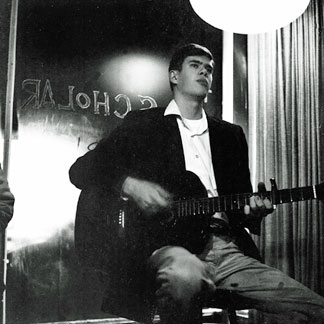
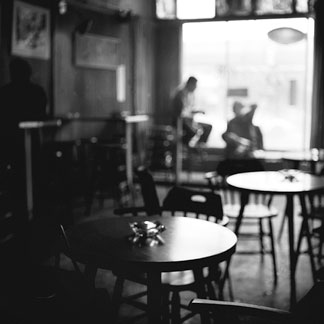
Dave Lee
Bream:
An informal, folk music performance policy developed under the Scholar’s second owner, Dave Lee, and the performers were paid.
1959
Zimmerman Becomes Dylan at the Scholar
The Scholar is, of course, famous as the place a young Bob Dylan performed from approximately September of 1959 through December of 1960. In his piece “Dylan’s Fortune,” (March 27, 1966) P.M. Clepper wrote that Dylan sang “traditional country-western songs in a nasal monotonous voice.” Dave Lee wrote that he regularly kicked Dylan out. “Dylan would come in and sing, and for a while it was all right, but that monotone would go on and Muriel would say to me ‘They’re beginning to leave. You’d better get rid of him.’” Clepper: “But he kept coming back, singing as if only for himself.”
When the Scholar was sold, Dylan got $2 a night because he was developing a following. But when he was refused a raise to $5, he moved on to the Bastille, and then got $6 at the Purple Onion in St. Paul.
Bob Fishman and Clark Batho
Bream:
The Scholar gained notoriety under its third owners, Bob Fishman and Clark H. Batho, who parked his Cadillac in front and told the chess players to “clear out when the paying customers came,” recalled Matheny, [who became chief artist for the Minneapolis Star.]
The University police occasionally checked the Scholar to verify complaints from “concerned faculty and parents,” according to [police], who characterized the place as a hangout for juveniles and runaways. He said the drug trafficking there was “heavy enough to issue a number of warrants and make a number of arrests.”
There followed a period of what Matheny and other members of the coffeehouse crowd characterized as harassment by police and restaurant licensing inspectors.
In 1961 the club was denied a food license and police closed it when they found out that Batho was serving food without a license. Batho was fined $25. Lt. A.G. Kirby of the University Police told the city council that the coffee house was “a hang-out for juveniles” and that one teenage girl was found there carrying a pistol.” Kirby also said that “teen-age patrons were consuming ‘large’ quantities of codeine cough medicine. He said at least eight bottles were recovered from the coffee house trash can.” (Minneapolis Tribune, November 21, 1961) Batho was selling real estate by January 1963.
1961
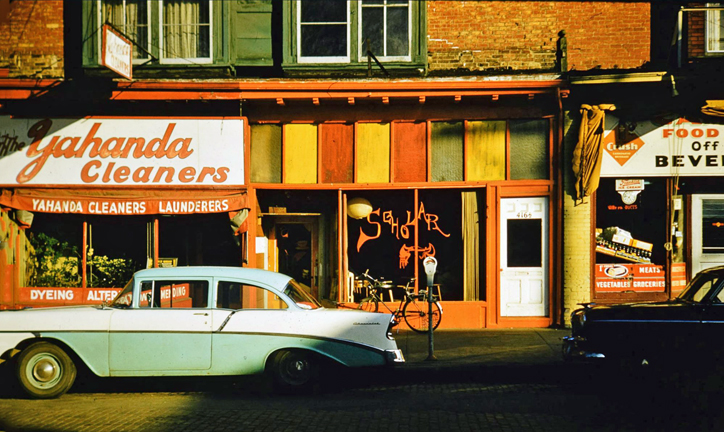
1962
A notice from December 1962 advertises folksingers every weekend and evening beginning at 8 pm. Sundays Maurice Bernstein sings Yiddish, European folk songs.
1963
Ann Oleson and Genie Evans
In 1963 Will Jones noted that it was purchased by Ann Oleson and Genie Evans that summer, and they celebrated by holding a Hootenanny.
Bream:
By 1963, Matheny said, “Id walk into the Scholar and it was packed with people I didn’t know.” By then, he added, regulars could make connections to buy marijuana through people who frequented the Scholar.
The July 1963 Twin Citian described “singing entertainment on weekends with good sandwiches served in an off-beat coffee house with murals adorning the walls. Particularly good for people watching. Here the students gather to converse, [???] and think.”
1964
Red Nelson
James “Red” Nelson bought the Scholar for $5,000 and a motorcycle. Red’s partners were Ann Mossman and Steve Oleson. Red Nelson would have afterparties at places called:
- The Red [Brick] Palace
- Ground Zero – across from 7 Corners
- Rainbow Gallery – a jazz place (see separate entry)
- The People’s Club – on Cedar Ave.
Bream:
Red Nelson called it a place “to hang out, play chess and go and talk – there was a lot of existentialism in those days. You had to have intellectual moxie. Professors would get into long philosophical discussions they couldn’t have in the classroom.”
As a business, the Scholar led a “hand-to-mouth existence,” said Nelson, a former member of the Minneapolis Park Board who was [in 1975] collecting workman’s compensation. The Scholar, which was usually open from noon to 2 am, charged 50 cents admission for its 80 or so seats on Friday and Saturday nights for performances of such local folk artists as John Koerner. Occasionally the place brought in nationally-known musicians, including Blind Lemon Jefferson.
THE GOPHER
The photo below appeared in the 1964 University of Minnesota Gopher Yearbook.
This might be an unattributed quote?
Several months after Dylan arrived on campus in Sept. 1959 he walked into “The Scholar” and said “Do you mind if I play? I want to be a folk singer.” According to Anthony Scaduto’s Dylan bio. . .He would soon be playing alongside “Spider” John Koerner who also often played with Dave Ray. . .There was a 4-inch raised stage in front of a large plate-glass window. The Scholar, as it was nicknamed, was a long room holding 90. It had unmatched tables and bar stools and a long bench along the wall. In the back was a coffee bar. A coffeeshop and place to hang out and play chess by day, at 9 pm folksingers, flamenco and blues guitarists, and poets would take over. . .Dylan would play here off and on between 1959-1960 until he moved to NYC in January of 1961. . .
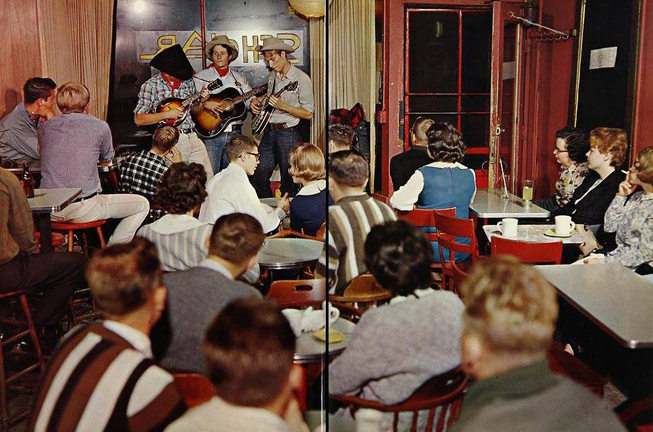
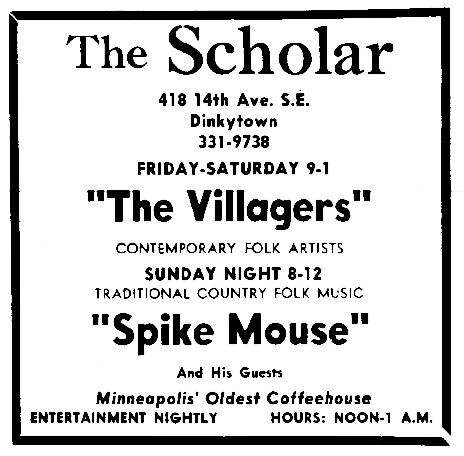
1965
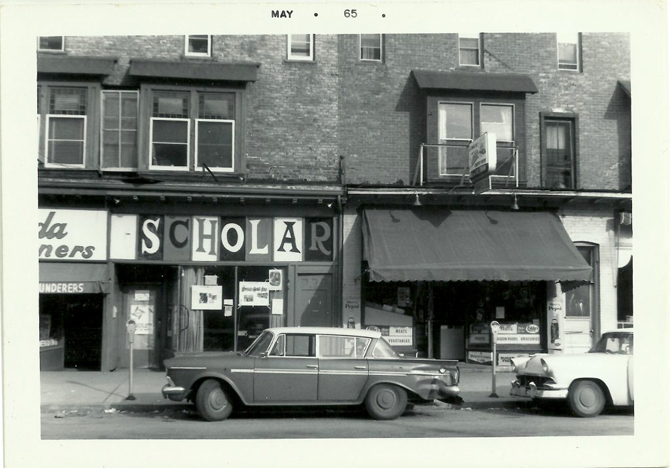
The building on 14th Ave. SE was demolished on January 9, 1973. Its space became part of a larger Subway sandwich store.
247 CEDAR AVE.
Mike Justen, “a young automotive parts man,” bought the Scholar in May 1965, and moved it to a former bar on the West Bank. It was closed by a fire in December 1965, apparently started in the grocery store next door. (Minneapolis Tribune, July 3, 1966)
1966
Although remodeling was incomplete, Justen opened at the new location in June 1966 and was met by standing-room-only crowds. Reporter Allan Holbert described it as a place where “college couples sit in front of abstract student art as they listen to abstract student jazz and drink abstract (but non-alcoholic) beverages.” (Minneapolis Tribune, July 3, 1966)
The new Scholar held about 100 people and served sandwiches, pizza, and coffee. Guitarist Leo Kottke noted that “when the pizza machine broke down it would interfere with the sound system.” (Bream)
Kottke made his first public appearances at the Scholar, noting that performing before audiences that are not drunk but paying attention taught him a lot. He recorded his first album live at the Scholar. (Bream)
1967

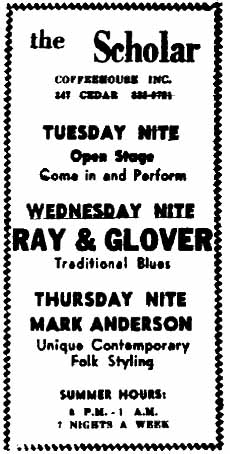
Steve Brust
Steve recorded his memories of the Scholar from 1965 to 1969. The following are some excerpts:
For me, starting in 1966, the Scholar Coffeehouse was an alternate home. And it was a fascinating place. The place was run by Mike Justen (I’ve seen the name spelled Justin), a casual and bright guy who was mellow unless he heard customers talking during a set, at which point he could bark with authority to restore an atmosphere of respect for the musician. The Scholar was a place to go if you were serious about enjoying what was being called folk music at the time.
The headline act, beyond question, was Leo Kottke. I think Leo played just about every other weekend. Sometimes he’d play at a tiny basement coffeehouse on the Macalester Campus, the Purple Onion, but the Scholar was his home in the Twin Cities.
Other acts included Papa John Kolstad (with or without the Sorry Muthas); Bill Hinckley and Judy Larson; the Middle Spunk Creek Boys; Koerner, Ray & Glover; Jeff Titon; and the duo of Jeff and Kit. I’ve forgotten many!
There were also fascinating people who hung around the place, including Maury Bernstein and Stephen Gammell (who had been a guitarist but is known now as the illustrator of children’s books).
The Scholar had seating for about 30 people. With no liquor license, the audience was very alert and generally respectful.
The Scholar was a great place to hang out. Mike could tell stories by the hour. When the lights went down, the place was pretty serious about music. The front door was terribly squeaky, and if you have a copy of the record Leo Kottke recorded there you’ll hear that door on one of his numbers.
I was convinced that Leo was a major talent, so I caught every performance of his that I possibly could attend. He was just as impressive musically and just as flaky as he ad-libbed between numbers as he is now. To hear him in an audience of 15 or 20 young folks whose faces were lit by tabletop candles was intimate, moving and memorable.
1969
The last hit in a search for the Scholar at 247 Cedar was on November 2, 1969. The location, plus the burned out former Bimbo’s building, became the new home of Theater in the Round.
At that point Mike Justen and Dennis Bursch opened the Oblivion Record Store with 50 albums in the front of the Scholar Coffeehouse. Oblivion closed in 1973.
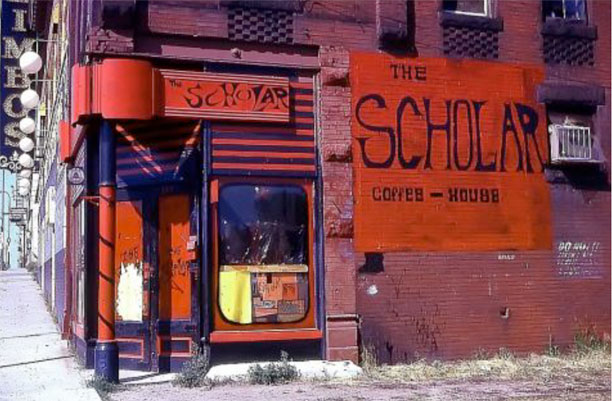
In the book West Bank Boogie by Cyn Collins (2006), Red noted that Ken Kesey and his Merry Pranksters pulled up to the Scholar in their bus one day, and drugs became the downfall of the mellow folk scene.


